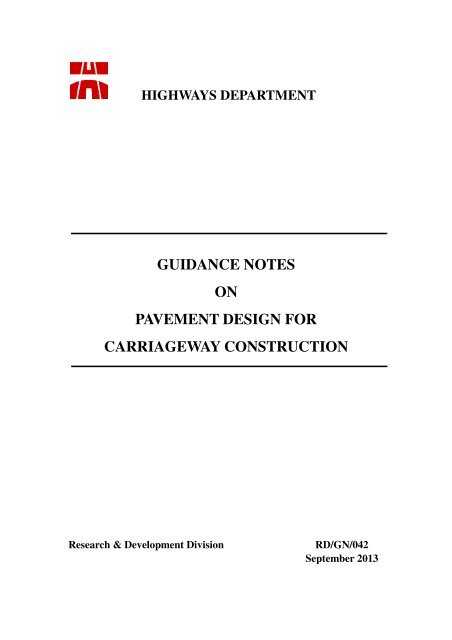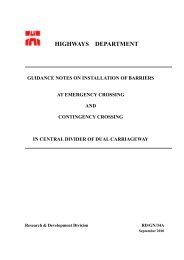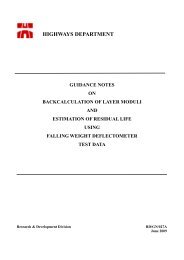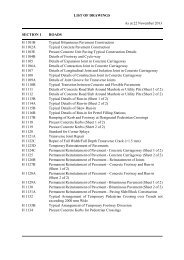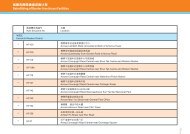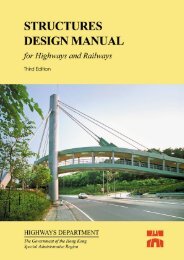Pavement Design for Carriageway Construction
Pavement Design for Carriageway Construction
Pavement Design for Carriageway Construction
You also want an ePaper? Increase the reach of your titles
YUMPU automatically turns print PDFs into web optimized ePapers that Google loves.
HIGHWAYS DEPARTMENTGUIDANCE NOTESONPAVEMENT DESIGN FORCARRIAGEWAY CONSTRUCTIONResearch & Development DivisionRD/GN/042September 2013
CONTENTS1. INTRODUCTION 4Page2. BACKGROUND 43. SELECTION OF PAVEMENT TYPE 53.1 General 53.2 Relative Advantages of Rigid <strong>Pavement</strong> in comparison with 6Flexible <strong>Pavement</strong>3.3 Overriding Factors 73.4 Situations where Rigid <strong>Pavement</strong> may be Preferred 74. FOUNDATION DESIGN 84.1 General 84.2 In-situ Subgrade Properties 84.3 Subgrade Treatments 94.4 Sub-base 105. DESIGN OF FLEXIBLE PAVEMENT 115.1 <strong>Pavement</strong> Model 115.2 <strong>Design</strong> Criteria 115.3 <strong>Design</strong> Life 125.4 Traffic Load 12(a) Commercial Vehicle Forecast(b) Commercial Vehicle Damage Factors(c) Distribution of Commercial Vehicles among Lanes(d) Lateral Wander(e) Step-by-step Calculation of <strong>Design</strong> Traffic Load5.5 Properties of Bituminous Materials 175.6 Structural <strong>Design</strong> 175.7 Composition and Thickness of Bituminous Layers 185.8 Selection of Surfacing Material 185.9 <strong>Design</strong> <strong>for</strong> Low-volume Road 19RD/GN/042 <strong>Pavement</strong> <strong>Design</strong> <strong>for</strong> <strong>Carriageway</strong> <strong>Construction</strong> Page 1 of 42
6. DESIGN OF RIGID PAVEMENT 206.1 <strong>Pavement</strong> Model 206.2 <strong>Design</strong> Criteria 20(a) Traffic-induced Stresses(b) Thermal Stresses(c) Fatigue Failure6.3 <strong>Design</strong> Life 216.4 Traffic Load 22(a) Commercial Vehicle Forecast(b) Average Number of Axles per Commercial Vehicle(c) Distribution of Commercial Vehicles among Lanes(d) Step-by-step Calculation of <strong>Design</strong> Traffic Load6.5 Modulus of Subgrade Reaction 236.6 Properties of Concrete 236.7 Structural <strong>Design</strong> 236.8 Types of Concrete <strong>Pavement</strong>s 24(a) Unrein<strong>for</strong>ced Concrete <strong>Pavement</strong>(b) Jointed Rein<strong>for</strong>ced Concrete <strong>Pavement</strong>6.9 Panelling <strong>Design</strong> and Joint <strong>Construction</strong> 256.10 Anti-skid Treatment 257. BLOCKED PAVING 268. PRINCIPLES FOR MISCELLANEOUS DETAILING 278.1 Transition between Flexible and Rigid <strong>Pavement</strong>s 278.2 Transition between At-grade <strong>Pavement</strong> and Bridge Abutment 278.3 Details of Edge Abutting Drainage Facilities or other Utility 27Pit Covers8.4 <strong>Pavement</strong> Drainage 288.5 Edge Constraint and Kerb Necessity 289. WORKED EXAMPLES 29RD/GN/042 <strong>Pavement</strong> <strong>Design</strong> <strong>for</strong> <strong>Carriageway</strong> <strong>Construction</strong> Page 2 of 42
DESIGN CHARTSPageChart 1 Bituminous pavement (E subgrade = 50MPa) 34Chart 2 Bituminous pavement (E subgrade = 100MPa) 35Chart 3 Bituminous pavement (E subgrade = 150MPa) 36Chart 4 Bituminous pavement (E subgrade = 200MPa) 37Chart 5 Bituminous pavement (E subgrade = 250MPa) 38Chart 6 Bituminous pavement (E subgrade = 300MPa) 39Chart 7 Concrete pavement (Slab Length = 4m) 40Chart 8 Concrete pavement (Slab Length = 5m) 41Chart 9 Concrete pavement (Slab Length >= 6m) 42RD/GN/042 <strong>Pavement</strong> <strong>Design</strong> <strong>for</strong> <strong>Carriageway</strong> <strong>Construction</strong> Page 3 of 42
1. INTRODUCTIONThis set of guidance notes is intended to serve as a comprehensive reference <strong>for</strong>highway practitioners on the design of carriageway pavements in Hong Kong. Itlays down the general principles and technical aspects to be considered whiledesigning a pavement <strong>for</strong> new roads or widening/reconstruction of an existing road.The step-by-step design procedures and easy-to-use design charts provided in HyDGuidance Notes No. RD/GN/017 (which is hereby superseded) are updated toincorporate the latest research findings.The recommendations given in this set of guidance notes are not intended to beexhaustive. As state-of-the-practice evolves and situation warrants, designers maywish to propose design modifications aiming at a more cost effective and durablepavement. <strong>Design</strong>s deviating from the provisions in this set of guidance notes shallbe subject to prior agreement from the Highways Department (HyD) if the completedworks will be handed over to the Department <strong>for</strong> maintenance.This set of guidance notes should be read in conjunction with other relevantguidelines. Where reference documents are quoted in this set of guidance notes,practitioners should refer to their latest version <strong>for</strong> the relevant details.2. BACKGROUNDThe pavement design guidance in Hong Kong has undergone certain stages ofdevelopment over the past few decades. Back in the 1970s or earlier, ‘<strong>Pavement</strong><strong>Design</strong>’ <strong>for</strong>med a chapter in the then Civil Engineering Manual, which was mostlybased on the empirical approach laid down in the United Kingdom Road Note 29 ofthat time.In view of the rapid progress of major road projects and the growing number of heavygoods vehicles in the territory, a revised version of road pavement design (known asRoad Note 1) was promulgated in 1983. It was intended to design more robust andlong lasting pavements to avoid any premature structural maintenance problemsassociated with under-design. A significant increase in the standard axle conversionfactor <strong>for</strong> commercial vehicles and the design life were thus adopted in the trafficloading assessment. Some changes in the subbase and capping layers were alsoadded to provide an improved foundation on weak subgrade.RD/GN/042 <strong>Pavement</strong> <strong>Design</strong> <strong>for</strong> <strong>Carriageway</strong> <strong>Construction</strong> Page 4 of 42
In 1991, a consultancy study, called Road Testing Programme, was commissioned byHyD to develop a pavement design system using the mechanistic-empirical approachamong other tasks. The mechanical properties of local asphaltic road base materialsand pavement quality concrete were evaluated through laboratory tests. The“Guidance Notes on <strong>Pavement</strong> <strong>Design</strong>” (RD/GN/017) was subsequently issued in1993 to incorporate those findings.In the past few years, comprehensive assessments were carried out by HyD to studythe overall conditions and maintenance needs of our road pavements. The resultsreflect that the general integrity of our pavement assets is in order. Regularmaintenance and surface rehabilitation could be able to upkeep our pavementserviceability effectively without leading to the bottom-up structural deterioration assuggested by classical pavement fatigue theory. The Research and Development(R&D) Division of HyD has also completed a series of in-house pavement relatedresearch studies with the findings presented in the respective technical reports.Equipped with internal research findings, and with reference to overseas developmenton the concept of long-life pavements toward the end of the 20 th century, the renewalstrategy <strong>for</strong> the local pavement design guidance is <strong>for</strong>mulated.In tandem with the above, with a view to reaping the best benefit from academics, acollaboration research study with the Hong Kong Polytechnic University commencedin 2012 to review RD/GN/017. The major findings serve to rein<strong>for</strong>ce the<strong>for</strong>mulation of this updated pavement design guidance.3. SELECTION OF PAVEMENT TYPE3.1 GeneralMany designers tend to adopt flexible pavement in new design, partly because of theperceived difficulty in repairs of rigid pavement in busy areas. However, thisapproach is not necessarily cost effective, in particular when the oil price is on a farsteeper rising trend in comparison with cement. Depending on the category of roads,maintenance difficulty of rigid pavement may not be an insurmountable factor either,taking into account the state-of-the-art technology.This section lays down the relative advantages and general selection criteria <strong>for</strong>RD/GN/042 <strong>Pavement</strong> <strong>Design</strong> <strong>for</strong> <strong>Carriageway</strong> <strong>Construction</strong> Page 5 of 42
flexible and rigid pavements as well as some overriding factors to be noted. Theserecommendations are based on a recent in-house study of the selection betweenflexible and rigid pavements with particular focus on local conditions.Application of blocked paving on carriageway shall only be considered under specialcircumstances, e.g. pedestrian areas or tourist attractions.3.2 Relative Advantages of Rigid <strong>Pavement</strong> in comparison with Flexible<strong>Pavement</strong>Rigid pavement is relatively inert to chemical attack and far less susceptible to surfacedistresses in <strong>for</strong>m of raveling and potholes than bituminous materials, thus can beconsidered in roads with frequent stationary usage by vehicles, including publictransport interchanges, side streets with regular loading/unloading activities inindustrial areas, lay-bys and car parks, to improve the overall durability and minimizethe maintenance needs.Elastic modulus and shear modulus of concrete are much greater than those ofbituminous mixtures. Under heavy axle loading and braking <strong>for</strong>ces, bituminouspavements are relatively vulnerable to certain defects, i.e. shoving, rutting,corrugation and slipping cracks. Rigid pavement would hence be far more durableover heavy braking zones, e.g. roads near/at container terminal, carriageway sectionsnear road junctions, at the bottom of downhill ramps and at sharp bends.Composite pavement, in the <strong>for</strong>m of some 100mm thick bituminous layers on some250mm thick continuously rein<strong>for</strong>ced concrete pavement, has gradually receivedattention in developed countries in the domain of long life pavement design. Thecontinuously rein<strong>for</strong>ced concrete base can serve as a very strong structural layer towithstand vehicular loading without being prone to reflective cracking because of itsjointless construction; whereas the uppermost bituminous surfacing can give betterriding com<strong>for</strong>t and be easier to maintain. Though its applicability would be limitedunder typical city roads with various site constraints and unavoidable utility openingworks over years, consideration on applying this particular pavement type may beworthwhile in planning <strong>for</strong> the sections of a new expressway or trunk road acrossvulnerable spots.To reap the highest benefit from different pavement types under specific siteconditions, an open and careful mind should be maintained to adopt the most suitableRD/GN/042 <strong>Pavement</strong> <strong>Design</strong> <strong>for</strong> <strong>Carriageway</strong> <strong>Construction</strong> Page 6 of 42
pavement type <strong>for</strong> different sections and/or different lanes on the same road. As ageneral guide, factors elaborated in section 3.3 below may be considered as overriding,whereas section 3.4 prescribes general situations when rigid pavement may bepreferred.3.3 Overriding FactorsFlexible pavement shall be adopted <strong>for</strong> road sections with designed vehicular speed ator exceeding 80km/h, or road sections subject to settlement; whereas rigid pavementis suitable <strong>for</strong> road sections on which frequent chemical attack, or frequent stop andgo or sharp turning manoeuvring of heavy vehicles, is expected.Other than the above specific situations, a road pavement may in general follow thetype of the adjoining road subject to considerations described below.3.4 Situations when Rigid <strong>Pavement</strong> may be PreferredFor roads not predominated by the above overriding factors, construction ofcarriageway using rigid pavement should be considered by the pavement designerswhen all the following prerequisites are fulfilled:(a)(b)(c)The pavement is not anticipated to have traffic of vehicular speed exceeding80km/h in normal circumstances;Busy traffic <strong>for</strong> the road section is not expected. In case of necessity <strong>for</strong> laneclosure <strong>for</strong> road maintenance or utility road opening works in future, the workswill not be <strong>for</strong>ced to be carried out outside normal working hours due to trafficconsiderations; andThere is no indication that frequency of utility road opening works along thecarriageway section would be high.RD/GN/042 <strong>Pavement</strong> <strong>Design</strong> <strong>for</strong> <strong>Carriageway</strong> <strong>Construction</strong> Page 7 of 42
4. FOUNDATION DESIGN4.1 GeneralThe condition of foundation support is a crucial factor to be considered whiledesigning a pavement structure. Adequate investigation of the in-situ subgradematerial should be conducted to assess its soil type, load bearing characteristics andmoisture susceptibility.4.2 In-situ Subgrade PropertiesThe design models <strong>for</strong> both flexible and rigid pavements, to be mentioned in Chapters5 and 6, require the strength of each layer of the pavement to be expressed as theelastic modulus. For granular soils, Cali<strong>for</strong>nia Bearing Ratio (CBR) test is the mostcommon way <strong>for</strong> determining the elastic modulus of subgrade. Reference can bemade to HyD Guidance Notes No. RD/GN/012 or relevant testing standard. Forcohesive soils or clays, plasticity index is always used <strong>for</strong> the determination of theelastic modulus of the subgrade. Some other non-destructive in-situ tests, <strong>for</strong>example Falling Weight Deflectometer and Dynamic Cone Penetrometer, can also beused to assess the elastic modulus of the subgrade.(a) CBR Tests (Granular Soils)There is no precise direct relationship between CBR values and the elasticmodulus of the subgrade. However, <strong>for</strong> granular soils, the followingrelationship is found satisfactory:E s= 10 x CBRwhere E s = elastic modulus of the subgrade [MPa]CBR = Cali<strong>for</strong>nia Bearing Ratio [%](b) Plasticity Index (Cohesive Soils)For cohesive soils, the CBR test is not very reliable. The followingrelationship allows the elastic modulus of the subgrade to be estimated from theplasticity index:E s= 70 - Ipwhere E s = elastic modulus of the subgrade [MPa]Ip = Plasticity Index [%]RD/GN/042 <strong>Pavement</strong> <strong>Design</strong> <strong>for</strong> <strong>Carriageway</strong> <strong>Construction</strong> Page 8 of 42
In-situ testing on the subgrade should be carried out to assess the elasticmodulus <strong>for</strong> pavement design as far as feasible. However, in cases when thesoil parameters are not available, guidance on typical values of elastic modulus<strong>for</strong> a range of subgrades listed in Table 1 can be referred to.Table 1 – Typical Values of Elastic Modulus of SubgradesSubgrade Type Elastic Modulus, E s (MPa)Cohesive soils (Clay) < 60Granular soils 50 – 300Rock/weathered rock > 300When the condition of subgrade is very weak or abruptly varied, it would resultin an engineering undesirable design option. The constructability is alsoquestionable. Appropriate treatments as suggested in the following sub-sectionshould be considered, whereas removal of weak in-situ material below the<strong>for</strong>mation level may be the last resort.4.3 Subgrade TreatmentFor subgrade of elastic modulus below 50MPa, strengthening measures are requiredin order to provide a strong and uni<strong>for</strong>m support <strong>for</strong> the pavement and to allow roadconstruction vehicles to pass over the subgrade without damaging the layer. Thiscan be achieved by providing a thick layer of sub-base on the subgrade but it may bemore economical to provide a capping layer of selected materials. The provision ofa capping layer over a weak subgrade avoids the necessity of an extraordinarily thicksub-base, and provides an adequate working plat<strong>for</strong>m <strong>for</strong> sub-base compaction as wellas reduces the risk of damage to the subgrade during construction. The CBR valueof the capping layer shall be of at least 15%.The recommended thicknesses of the capping layer <strong>for</strong> various CBR values ofsubgrade <strong>for</strong> flexible and rigid pavements are shown in Table 2.The capping layer can be specified as granular fill material in accordance with Section6 of the General Specification <strong>for</strong> Civil Engineering Works.RD/GN/042 <strong>Pavement</strong> <strong>Design</strong> <strong>for</strong> <strong>Carriageway</strong> <strong>Construction</strong> Page 9 of 42
4.4 Sub-baseThe sub-base <strong>for</strong>ms the upper layer of the pavement foundation and provides aregulated working plat<strong>for</strong>m on which to transport, place and compact the bound layersof the pavement. Within a flexible pavement structure, the sub-base is also treatedas a structural layer to spread the loading from the surface down to the subgrade.Sub-base shall be specified as granular material in accordance with Section 9 of theGeneral Specification <strong>for</strong> Civil Engineering Works. Lean concrete is generally notrecommended <strong>for</strong> sub-base application. For flexible pavements, localised shrinkagecracks developed in the lean concrete sub-base would likely propagate upwardsthrough the bituminous surfacing causing reflective cracking at the pavement surface,which reduces the service life of pavement. For rigid pavements, the high rigidityand flexural strength of concrete itself contribute to most of the load bearing function,resulting in very small deflections and pressures induced by vehicular loading on thesub-layers. The purpose of sub-base on rigid pavements is primarily <strong>for</strong> controllingpumping, which can be achieved by using granular materials.The thickness of the sub-base layer is determined primarily from the strength of thesubgrade, i.e. the CBR value.<strong>for</strong> flexible and rigid pavements are shown in Table 2.The recommended thicknesses and type of sub-baseTable 2 – Capping Layer and Sub-base Recommendations<strong>for</strong> Flexible and Rigid <strong>Pavement</strong>sSubgradeModulus ofSubgradeCBRSubgradePlasticityMinimum Thickness[mm]Elasticity[MPa]Value[%]Index (I p )[%]CappingLayerGranularSub-base50 600 15020 – 20 – 50 350 15050 –
5. DESIGN OF FLEXIBLE PAVEMENT5.1 <strong>Pavement</strong> ModelFlexible pavement structure is assumed to behave elastically under the dynamic loadsexerted by vehicular traffic. Linear elastic theory <strong>for</strong> layered system is adopted tocalculate the stress/strain distribution within a pavement structure in response totraffic load.Although a flexible pavement structure is typically constructed in several layers, it ismodelled as a three-layered system <strong>for</strong> design purposes as presented in Figure 1.All the bituminous layers, including wearing course, base course and roadbase, arecombined into one layer. The materials are assumed as homogeneous and isotropicand are characterized by the modulus of elasticity (E) and Poisson’s Ratio (ν). Aconstant value of 0.35 is assumed <strong>for</strong> the Poisson’s ratios of all the layers.Figure 1 – Three-layered flexible pavement model5.2 <strong>Design</strong> CriteriaTwo classical failure modes are considered in designing flexible pavements, i.e.fatigue cracking and permanent de<strong>for</strong>mation.Fatigue cracking is defined as the phenomenon of fracture under repeated orRD/GN/042 <strong>Pavement</strong> <strong>Design</strong> <strong>for</strong> <strong>Carriageway</strong> <strong>Construction</strong> Page 11 of 42
fluctuating stress having a maximum value generally less than the tensile strength ofthe materials. Under traffic loading, flexible pavement structure experiencescontinuous flexing. Provided that the bituminous layers are fully bonded, theinitiation of fatigue cracks would be governed by the horizontal tensile strain at thebottom of the bituminous road base.Permanent de<strong>for</strong>mation refers to the pavement material under the wheel pathcontinually consolidating and settling under repeated traffic loading to <strong>for</strong>m a grooveor rut. Bituminous materials with continuously graded aggregates or largeproportion of coarse aggregate content and good volumetric composition are likely tobe able to resist the permanent de<strong>for</strong>mation. Strong foundation support alsoimproves the resistance to rutting. Such de<strong>for</strong>mations primarily depend on thevertical compressive strain at the surface of subgrade.It should be noted that when the thickness of bituminous layers increases, the chanceof occurrence of the above mentioned failure modes reduces. Up to certain thickness,a pavement structure would behave as ‘long-life’. Overseas experiences and studiesdraw a threshold at the condition when the critical horizontal tensile strain at thebottom of bituminous road base is less than 70 microns. Under such condition, thepavement deterioration would mostly be initiated from the surface rather thanfollowing the classical bottom-up fatigue failure mechanism. The surface distressescan then be rectified by timely rehabilitation to stop them from propagatingdownwards in order to effectively preserve the overall integrity of the structure.5.3 <strong>Design</strong> LifeTo achieve a design of low life-cycle cost and in respect of the high social cost <strong>for</strong> fulldepth reconstruction, a design life of 40 years is generally recommended <strong>for</strong> flexiblepavements. Within this life span, it is expected that no structural maintenance isrequired under normal circumstances and the service life of the pavement structurecan be sustained by minor repairs coupled with resurfacing at appropriate intervals.Due to the low tensile strain to be incurred at bottom of the road base, if sufficientthickness is designed, it is anticipated that the service life can be further extended bysuitable surface rehabilitation measures upon ‘expiry’ of the original ‘design life’.5.4 Traffic LoadThe design traffic load shall be determined by considering the factors mentionedRD/GN/042 <strong>Pavement</strong> <strong>Design</strong> <strong>for</strong> <strong>Carriageway</strong> <strong>Construction</strong> Page 12 of 42
elow. The combined damaging effect of vehicular traffic is collectively expressedas a cumulative number of equivalent standard axles with a 80kN single axledual-wheel configuration with tyre pressure of 0.577 MPa (Figure 2 refers).Figure 2 – Configuration of an Equivalent Standard Axle(a) Commercial Vehicle ForecastThe definition of commercial vehicle follows the one given in the AnnualTraffic Census published by Transport Department, which includes medium /heavy goods vehicle and bus. Other light vehicles, <strong>for</strong> examples, motor cycle,private car and public light bus, are normally ignored as their induced structuraldamage on pavements is minimal. The annual flow of commercial vehicles atthe time of road opening is obtained by multiplying the daily flow by 365days/year. The cumulative number of commercial vehicles using a road duringits design life is obtained by summing up the annual traffic of each year takinginto consideration the predicted growth rate. The <strong>for</strong>ecast can be done withreference to on-site traffic count data, traffic census or other available trafficstudies or planning data.(b) Commercial Vehicle Damage FactorsCommercial vehicle damage factors (CVDF) are the numbers of equivalentstandard axles per class of commercial vehicles, taking into account thecumulative damage effects arising from different axle loads of vehicles. Itdepends on the number and weight of all the axles per vehicle class. Withreference to sampled axle load surveys in the nineties and a review of sampledload spectrum data collected in 2012 from the weigh-in-motion sensors atRD/GN/042 <strong>Pavement</strong> <strong>Design</strong> <strong>for</strong> <strong>Carriageway</strong> <strong>Construction</strong> Page 13 of 42
Lantau Fixed Crossing, Ting Kau Bridge and Shenzhen Western Corridor, a setof CVDF are recommended in Table 3. For pavement design purpose, aweighted mean of these factors shall be determined in order to obtain an overallCVDF to represent the structural damaging effect resulted from the cumulativenumber of commercial vehicles during the design life.Table 3 – Commercial Vehicle Damage FactorsClass of commercial vehicleCVDF(No. of standard axles / vehicle)Medium & heavy goods vehicle 3.3Bus 2.9For situations when the composition of commercial vehicle classes is not readilypredictable, it is recommended an average of the two factors given in Table 3 beadopted in the design.(c) Distribution of Commercial Vehicles among LanesFollowing the general driving behavior and legal restrictions, it can be assumedthat a higher percentage of commercial vehicles along a multi-lane carriagewaywould travel along the nearside slow lane. Depending on the actual trafficvolume and the proportion of commercial vehicles, a different split among laneswill occur at different road sections.For design purposes, it is generally recommended, based on statistical datacollected from typical local highway sections, that 65% of the commercialvehicles be assumed travelling in the slow lane. However, in no case should theestimated number of commercial vehicles using the slow lane exceed the trafficcapacity of that lane. The estimated number of vehicles should there<strong>for</strong>e bechecked to ensure that it does not exceed the capacity of the lane. Guidance onthis can be obtained from the Transport Planning and <strong>Design</strong> Manual(TPDM), Volume 2.For new roads or full reconstruction projects, all traffic lanes, including the hardshoulders, shall be designed and constructed to cater <strong>for</strong> the most heavilytrafficked scenario, normally along the slow lane. The same considerationshall be given to projects under which only partial reconstruction of existingcarriageway pavement is involved.RD/GN/042 <strong>Pavement</strong> <strong>Design</strong> <strong>for</strong> <strong>Carriageway</strong> <strong>Construction</strong> Page 14 of 42
(d) Lateral WanderThe cumulative number of commercial vehicles using a pavement during itsdesign life shall be corrected <strong>for</strong> the positive effect of lateral wander of vehicleswithin or across the traffic lanes. The lateral wander correction factors (W f ) <strong>for</strong>flexible pavements are shown in Table 4. For an intermediate lane width, anappropriate factor may be derived by interpolation.Table 4 - Lateral Wander Correction FactorsLane Width (m) Lateral Wander Correction Factor (W f )3.00 1.003.37 0.963.50 0.953.65 0.923.75 0.90(e) Step-by-step Calculation of <strong>Design</strong> Traffic LoadThe anticipated number of equivalent standard axles <strong>for</strong> structural design isdetermined according to the following steps.Step 1 - Determine the design initial average daily traffic flow (AADT d )AADT d = AADT b x (1 + r) m [vehicles/day]where AADT b = base annual average daily traffic flow [vehicle/day]r = annual traffic growth rate [in decimal], from past trafficfigures or from Transport Department (typical valuesranging from 0.01 to 0.04)m = length of period between timing in AADT b and the timethat the road is expected to open to traffic [years]Step 2 -Determine the initial daily number of commercial vehicles (C e ) in theslow lane in one directionC e = P s x P v x D s x AADT d [no. of commercial veh./day]where P s = percentage of commercial vehicles using slow lane= 1 where there is only 1 traffic lane in the directionconcerned; or0.65 <strong>for</strong> other casesP v = percentage of commercial vehicles in AADT b ,RD/GN/042 <strong>Pavement</strong> <strong>Design</strong> <strong>for</strong> <strong>Carriageway</strong> <strong>Construction</strong> Page 15 of 42
D s = directional split factor= 1 <strong>for</strong> 1-way roads; or0.55 <strong>for</strong> 2-way roads (assuming 55%/45% split)Step 3 -Determine the cumulative number of commercial vehicles (C v ) using theslow lane during the design lifeCv( 1+r)n−1= 365×Ce×[ no.of commercial vehicles]rwhere r = annual traffic growth rate [in decimal]n = design life [years]Step 4 -Check that Cv does not exceed the design flow capacity of the trafficlane (C d )where n = design life [years]D f = maximum design flow [vehicles per hour per lane]recommended in the TPDM, Volume 2 Chapter 2K p = peak hour factor recommended in Table 5ExpresswaysUrban Trunk RoadsPrimary DistributorRural Trunk RoadsRural RoadsDfCv ≤ Cd= 365×n × [ no.of vehicles]KDistrict DistributorsLocal DistributorspTable 5 – Peak Hour FactorRoad Type Peak Hour Factor (K p )0.050.0650.08Step 5 -Determine the design traffic load (C n ) <strong>for</strong> flexible pavementsC n = C v x CVDF x W f[million standard axles]where CVDF = weighted mean of commercial vehicle damage factors[standard axle / commercial vehicle] recommended inTable 3W f = lateral wander correction factor recommended in Table 4RD/GN/042 <strong>Pavement</strong> <strong>Design</strong> <strong>for</strong> <strong>Carriageway</strong> <strong>Construction</strong> Page 16 of 42
5.5 Properties of Bituminous MaterialsThe mechanical properties of bituminous materials vary with temperature, loadingtime and mixture types. In the analytical design of flexible pavements, elasticmodulus of bituminous materials is adopted as one of the input parameters.The design charts provided in this guidance were developed based on the typicalbituminous road base material, with their properties determined under the ‘RoadTesting Programme’ consultancy study completed in early nineties.5.6 Structural <strong>Design</strong><strong>Design</strong> charts 1 to 6 are <strong>for</strong> structural design of flexible pavements in Hong Kong.These charts were established taking into account the local environmental conditions,the properties of conventional pavement materials and the two critical failure modes.The required total thickness of the bituminous materials can be obtained by checkingagainst the design traffic load estimated in section 5.4 and modulus of elasticity ofsubgrade ranging from 50 MPa to 300 MPa. Taking account of the concept of‘long-life pavement’, a lower and upper bound <strong>for</strong> pavement thickness as given inTable 6 should be observed.Table 6 – Lower and Upper Bounds <strong>for</strong> Total Thickness of Bituminous <strong>Pavement</strong>Road Type Lower Bound (mm) Upper Bound (mm)Expressway350 500Trunk RoadPrimary DistributorOthers 280 * 500* lower bound can be reduced to 205mm <strong>for</strong> roads with AADT
certain substantial value, the tensile strain at the bottom of the road base that might beinduced by the axle load of a commercial vehicle would be low enough to avoid thechance of fatigue failure no matter how large is the traffic volume. As such, an upperbound is set <strong>for</strong> the bituminous pavement thickness so that a pavement structurewould not be over-designed.When the modulus of elasticity of the subgrade is less than 50 MPa but where cappingand sub-base layers are provided in accordance with Table 2, <strong>Design</strong> Chart No. 1 (50MPa) can be used. For intermediate values of subgrade strength, the appropriatethickness can be obtained by interpolation.Owing to the large amount of air voids in the porous friction course material, it is notclassified as a structural layer and the thickness of the porous friction course wouldnot contribute to the required thickness of the bituminous layers.5.7 Composition and Thickness of Bituminous LayersThe composition of bituminous layers within a flexible pavement structure and theirrecommended thicknesses shall be as indicated in HyD Standard Drawing No.H1101.5.8 Selection of Surfacing MaterialThe role of surfacing layer in a bituminous pavement structure is to resist repeatedtraffic load and environmental weathering. Moreover, it should provide necessaryskid resistance and riding com<strong>for</strong>t to serve the vehicular traffic.Three main types of bituminous surfacing are locally available, namely ordinarywearing course material, stone mastic asphalt material and porous friction coursematerial. Their mechanical properties, and durability characteristics in terms ofrutting and cracking, vary depending on the aggregate grading and bitumen type andcontent. These factors have to be carefully considered in the selection process to suitthe anticipated usage.Ordinary wearing course material is technically referred as dense graded orcontinuously graded bituminous mixture. It is suitable <strong>for</strong> general carriageway as animpermeable and smooth surfacing layer.RD/GN/042 <strong>Pavement</strong> <strong>Design</strong> <strong>for</strong> <strong>Carriageway</strong> <strong>Construction</strong> Page 18 of 42
Stone mastic asphalt material (SMA), known as a gap graded material, consists ofhigh coarse aggregate content, high binder and filler content with added fibre to stopbitumen drain down and give additional binder stability. The strong rut resistanceprovided by its stone-on-stone skeleton is particularly suitable <strong>for</strong> road sections withheavy axle loads and frequent stop-and-go traffic. Detailed guidelines on itsapplication are given in HyD Guidance Notes No. RD/GN/038.Porous friction course has a similar coarse aggregate skeleton as SMA but a smalleramount of sand/filler mortar. This sort of open-graded bituminous mixture, with ahigher percentage of interconnecting void content, becomes permeable and canfacilitate effective surface drainage. Its high porosity results in a lower tensilestrength and fatigue resistance, making friction course being considered as anon-structural layer from a conservative design perspective. Detailed guidelines onits application are given in HyD Guidance Notes No. RD/GN/032.For particular location with skidding concern but not practically feasible to be tackledby large-scale modification of the road geometry, provision of anti-skid surfacedressing would be an alternative technical solution. Reference shall be made to HyDGuidance Notes No. RD/GN/038 <strong>for</strong> the design consideration.5.9 <strong>Design</strong> <strong>for</strong> Low-volume RoadsFor certain local, rural or feeder roads (AADT < 400), it can be envisaged that thosecarriageway sections are mostly trafficked by light vehicles with a rare number ofheavy vehicles. They can be referred as low-volume roads.The minimum thicknesses specified in the design charts may cause these low-volumeroads to be resulted in a highly conservative structural design. Under suchcircumstances, the designer is suggested to determine the bituminous layer thicknessdirectly from the design curves based on the design traffic load whereas the minimumroad base thickness could be reduced to 100 mm. With this reduced thickness,tensile strain under incidental heavy axle loads could exceed the threshold, and maylead to random fatigue cracks upon expiry of the original ‘design life’ of the pavement.However, due to the low traffic volume, the service life could be extended by coldmilling and resurfacing of the wearing course and base course only, albeit at relativelyfrequent yet tolerable intervals.RD/GN/042 <strong>Pavement</strong> <strong>Design</strong> <strong>for</strong> <strong>Carriageway</strong> <strong>Construction</strong> Page 19 of 42
6. DESIGN OF RIGID PAVEMENT6.1 <strong>Pavement</strong> ModelRigid pavement consists of concrete slab and sub-base on top of the subgrade.Modulus of elasticity of concrete slab is normally much greater than that of granularsub-base and in-situ subgrade, resulting in most of the load bearing capacity of apavement being attributed to the strength of the concrete slab. Stresses in rigidpavements are induced by traffic loads and cyclic temperature changes of concreteslab, with their magnitudes also depending on the in-situ subgrade support.For design purposes, longitudinally and transversely jointed concrete slabs aremodelled as a system of hinged connected slabs on an elastic foundation thatcomprises the subgrade and the overlying sub-base. The elastic foundation issimulated by a series of springs of constant stiffness, which are characterised by themodulus of subgrade reaction. Only one slab is considered in the structural design,and the adjacent slabs are modelled to allow a reduction of the imposed loads alongthe edge of this slab. The pavement model is shown in Figure 3 <strong>for</strong> calculating thetraffic-induced stresses across the slab.Figure 3 – Model of Concrete <strong>Pavement</strong>6.2 <strong>Design</strong> Criteria(a) Traffic-induced StressesBending of a concrete slab due to traffic loading will generate both compressiveand tensile stresses within the slab. In general, the thickness of the slab will begoverned by maximum tensile stress within the slab.The critical loading point is along the slab edges in both longitudinal andRD/GN/042 <strong>Pavement</strong> <strong>Design</strong> <strong>for</strong> <strong>Carriageway</strong> <strong>Construction</strong> Page 20 of 42
transverse directions. The stresses can be reduced by providing an effectivemechanism, such as dowels or tie bars, to transfer part of the loads to theadjacent slabs.(b) Thermal StressesThermal stresses consist of two components, i.e. uni<strong>for</strong>m longitudinal stressesover the cross-section of the concrete due to seasonal temperature variations andwarping stresses due to daily temperature gradient change.Longitudinal tensile stresses develop when the concrete cools and its contractionis prevented by the friction between the concrete slab and sub-base. Stressesare greatest in the centre of the slab and increase with longer slabs.Warping stresses are the result of an uneven temperature distribution over thecross-section of the slab. If the top surface of a slab is warmer than the bottomsurface, the slab becomes convex but its own gravity opposes such stress-freedistortion, resulting in compressive stresses at the top and tensile stresses at thebottom of the slab.(c) Fatigue FailureConcrete is subject to the effects of fatigue which are induced by repeated trafficloading and temperature variations. The fatigue behaviour of concrete dependson the stress ratio which is the quotient of tensile stress and modulus of ruptureof concrete. Individual damage of axle loads is accumulated using Miner’srule to assess the pavement failure.6.3 <strong>Design</strong> LifeTo achieve a design of low life cycle cost and in respect of the high social cost <strong>for</strong> fulldepth reconstruction, the design life <strong>for</strong> rigid pavement is generally recommended as40 years. Within this life span, it is expected that no extensive rehabilitation isrequired under normal circumstances and the service life of the pavement structurecan be sustained by minor repairs. It is anticipated that the service life can be furtherextended upon ‘expiry’ of the original ‘design life’ by timely maintenance andlocalized bay replacement.RD/GN/042 <strong>Pavement</strong> <strong>Design</strong> <strong>for</strong> <strong>Carriageway</strong> <strong>Construction</strong> Page 21 of 42
6.4 Traffic LoadThe non-linear load transfer mechanism and the non-linear fatigue damage occurringin rigid pavements hinder the practicality of expressing traffic load in term ofequivalent standard axles. The damage induced by different loading conditions andmagnitudes are separately analysed by referring to a standard axle load spectrumwhich was derived from sampled axle load data to represent the local trafficcharacteristic. Previous axle weighing studies also gave an average number of axlesper commercial vehicle as the basis <strong>for</strong> rigid pavement design. <strong>Design</strong>ers shallconsider the following factors while determining the design traffic load.(a) Commercial Vehicle ForecastThe procedures and considerations in <strong>for</strong>ecasting the number of commercialvehicles <strong>for</strong> rigid pavement design are identical to those described in section5.4(a) <strong>for</strong> flexible pavements.(b) Average Number of Axles per Commercial VehicleThe predicted number of commercial vehicles is converted to number of axlesby multiplying the number of commercial vehicles by the average number ofaxles (A a ) per commercial vehicle which is recommended to be 3.1.(c) Distribution of Commercial Vehicles among LanesThe procedures and considerations in <strong>for</strong>ecasting the distribution of commercialvehicles among traffic lanes <strong>for</strong> rigid pavement design are identical to thosedescribed in section 5.4(c) <strong>for</strong> flexible pavements.(d) Step-by-step Calculation of <strong>Design</strong> Traffic LoadThe steps <strong>for</strong> determining the anticipated number of axles <strong>for</strong> structural designof rigid pavement is identical to those <strong>for</strong> flexible pavement, except step 5below.Step 5 -Determine the design traffic load (C a ) <strong>for</strong> rigid pavementsC a = A a x C v [axles]where A a = average number of axles per commercial vehicleRD/GN/042 <strong>Pavement</strong> <strong>Design</strong> <strong>for</strong> <strong>Carriageway</strong> <strong>Construction</strong> Page 22 of 42
[axle/vehicle]= 3.16.5 Modulus of Subgrade ReactionIn the design analysis, it is assumed that the reactive pressure provided by thesub-base/subgrade material under a concrete slab is proportional to the de<strong>for</strong>mationbelow the point of loading. The ratio is known as the ‘modulus of subgrade reaction’or ‘k-value’.By using Table 7, the k-value can be estimated from the elastic modulus of thesubgrade, the thickness and modulus of elasticity of the sub-base, in which the elasticmodulus of subgrade should be assessed on-site wherever possible.Table 7 – Modulus of Subgrade Reaction (k) [in N/mm 3 or MPa/mm]E subgradeThickness of Granular Sub-base(MPa) 150 mm 225 mm 300 mm50 0.045 0.050 0.060100 0.060 0.075 0.090150 0.075 0.090 0.110200 0.085 0.105 0.125250 0.095 0.115 0.140300 0.100 0.125 0.1506.6 Properties of ConcreteGrade 40/20 concrete is specified <strong>for</strong> the construction of rigid pavements in HongKong. The following material properties are adopted in the pavement analysis <strong>for</strong>developing <strong>Design</strong> Charts 7 to 9.Modulus of rupture = 5.25 MPaModulus of elasticity = 33,000 MPaPoisson’s ratio = 0.15Temperature differential = 2.7 o C within typical slab thickness6.7 Structural <strong>Design</strong>For structural design of rigid pavements, <strong>Design</strong> Charts 7 to 9 shall be followed <strong>for</strong>slab length of 4m, 5m, and greater than or equal to 6m respectively.RD/GN/042 <strong>Pavement</strong> <strong>Design</strong> <strong>for</strong> <strong>Carriageway</strong> <strong>Construction</strong> Page 23 of 42
6.8 Types of Concrete <strong>Pavement</strong>sDescriptions and characteristics of two common types of concrete pavements, namelyunrein<strong>for</strong>ced concrete pavement (also known as jointed plain concrete pavement) andjointed rein<strong>for</strong>ced concrete pavement, are mentioned below. <strong>Construction</strong> detailswill be elaborated in later paragraphs. Further guidance on slab length andrein<strong>for</strong>cement detail is given on HyD Standard Drawing No. H1102.When a particular situation is considered necessary, special design by usingcontinuously rein<strong>for</strong>ced concrete pavement may be explored.(a) Unrein<strong>for</strong>ced concrete pavementFor slab length not more than 5m, thermal and shrinkage effects within theconcrete slabs can be released at saw-cut contraction joints timely provided inthe construction, so that transverse cracking could be developed at the designedlocations with no particular need of crack control using mesh rein<strong>for</strong>cement.To ensure proper load transfer across the contraction joints, dowel bars have tobe installed between them.The smaller size of unrein<strong>for</strong>ced concrete slabs is, by nature, more suitable <strong>for</strong>areas with higher density of metal works since the provision of box-outs is by allmeans required. Plain slab design allows the possibility <strong>for</strong> continuous pouringand potential cost saving on steel rein<strong>for</strong>cements and joint sealants though someextra saw-cutting and dowel installation works are needed.(b) Jointed rein<strong>for</strong>ced concrete pavementFor slab length longer than 5m, mesh rein<strong>for</strong>cement shall be provided inaccordance with the requirements given in Table 8 to assist the distribution oftraffic and thermal stresses.With fewer transverse joints, jointed rein<strong>for</strong>ced concrete pavement behavesmore robust and is less likely to have slab rocking/faulting or full panel crackedthrough kind of defects developed. In the nineties, there were concerns thatwider sealing groove might be more vulnerable to joint defects, such as loss ofsealant and joint spalling. With a well-established inspection and maintenanceRD/GN/042 <strong>Pavement</strong> <strong>Design</strong> <strong>for</strong> <strong>Carriageway</strong> <strong>Construction</strong> Page 24 of 42
system in place and the improvement of sealant’s technology over decades, suchproblem is believed not prevailing. Over locations with rare chance of utilityexcavation, like roadside bus bays or public transport interchange, the use ofrein<strong>for</strong>ced concrete slabs may bring in longer term durability benefit.Table 8 – Minimum Rein<strong>for</strong>cement RequirementsConcrete SlabThickness(mm)Meshkg/m2Mainmm 2 /mCross SectionCrossmm 2 /m< 170 2.61 283 49170 – 210 3.41 385 49210 – 235 4.34 503 49235 – 300 5.55 636 70.86.9 Panelling <strong>Design</strong> and Joint <strong>Construction</strong>Proper panelling design and construction of joints in concrete slabs are vital to thesustainability and serviceability of rigid pavements. Unlike the continuous nature offlexible pavement, sufficient discontinuities are purposely provided between theconcrete slabs to allow thermal movements. The physical width of concrete slab isnormally designed to match the traffic lane width, and separated by longitudinal jointsto prevent longitudinal cracking. Along the traffic directions, suitable spacing andtypes of transverse joints shall be provided <strong>for</strong> thermal contraction and expansion and<strong>for</strong> isolation among the roads at their intersections. Guidance on the paneling designand joint construction details <strong>for</strong> concrete slabs is given in HyD Guidance Notes No.RD/GN/020 and HyD Standard Drawing Nos. H1105 to H1109.6.10 Anti-skid TreatmentFor particular location with skidding concern but not practically feasible to be tackledby large-scale modification of the road geometry, provision of anti-skid treatmentwould be an alternative technical solution. Reference shall be made to HyDGuidance Notes No. RD/GN/037.RD/GN/042 <strong>Pavement</strong> <strong>Design</strong> <strong>for</strong> <strong>Carriageway</strong> <strong>Construction</strong> Page 25 of 42
7. BLOCKED PAVINGRun-in and carriageway pavements are directly exposed to vehicular traffic. Whenblocked paving is designed to be laid over such areas, special attention should be paidin both material selection and construction detailing to ensure its durability andserviceability. <strong>Design</strong>ers shall refer to Section 11 of the General Specification <strong>for</strong>Civil Engineering Works <strong>for</strong> the technical requirements and relevant HyD standarddrawings <strong>for</strong> the typical construction details.Geogrid may be considered to be laid underneath block paved roads sustaining heavytraffic to improve the resistance to permanent settlement. Such provision may,however, impose certain practical difficulties in future road opening and associatedreinstatement works. A balanced consideration shall be taken depending onindividual site condition.For any special design involving non-standard details of paving units to be handedover to HyD <strong>for</strong> maintenance, Regional Offices and Landscape Unit of theDepartment shall be consulted in advance.RD/GN/042 <strong>Pavement</strong> <strong>Design</strong> <strong>for</strong> <strong>Carriageway</strong> <strong>Construction</strong> Page 26 of 42
8 PRINCIPLES FOR MISCELLANEOUS DETAILINGThis section highlights the principles and reference <strong>for</strong> certain detailing to be notedwhile per<strong>for</strong>ming a comprehensive pavement design.8.1 Transition between Flexible and Rigid <strong>Pavement</strong>sDifferent pavement structural layers will undergo certain extents of de<strong>for</strong>mation undertraffic loading. Although the de<strong>for</strong>mation is mostly transient and recoverable,long-term permanent de<strong>for</strong>mation still exists and largely depends on the materialstrength and stiffness. The differential settlement accumulated at the transitionbetween flexible and rigid pavements would not only affect the riding com<strong>for</strong>t butalso lead to rapid deterioration. Provision of transition slab is required to minimizesuch effect. Typical construction detail is given in HyD Standard Drawing No.H1110.Notwithstanding the above, provision of transition slab between a flexiblecarriageway and the adjacent concrete bus bay may not be feasible. Regularmonitoring and timely maintenance would be required to upkeep the serviceabilityand durability.8.2 Transition between At-grade <strong>Pavement</strong> and Bridge AbutmentTo deal with the situation as mentioned in section 8.1 above, similar detailing shouldalso be provided at the transition between at-grade pavement and bridge abutment toensure the carriageway pavement functions properly and durably.8.3 Details of Edge Abutting Drainage Facilities or other Utility Pit CoversFor construction details to cope with roadside gullies, reference shall be made to HyDStandard Drawing Nos. H3107 and H3108 <strong>for</strong> rigid and flexible pavementsrespectively.For construction details of concrete road slab and joint arrangement around manholeor utility pit, reference shall be made to HyD Standard Drawing Nos. H1111 andH1112. When situation warrants, pit covers should be aligned orthogonally to thecarriageway. Consideration should be given to place all kinds of frames and covers,except gully grating, near the lane centre as far as practicable.RD/GN/042 <strong>Pavement</strong> <strong>Design</strong> <strong>for</strong> <strong>Carriageway</strong> <strong>Construction</strong> Page 27 of 42
8.4 <strong>Pavement</strong> DrainageProper drainage shall be provided to effectively discharge the surface runoff fromcarriageways to ensure the road safety during wet seasons and to minimize thepavement deterioration accelerated by ponding. The design shall follow therecommendations given in HyD Guidance Notes No. RD/GN/035.While friction course is designed as the uppermost pavement layer, the installationdetails of gully grating shall be designed in accordance with HyD Standard DrawingNo. H3106.It is also of vital importance to provide efficient drainage to remove water from thesubgrade, capping and sub-base layers both during construction and in-service stages.Where necessary, appropriate sub-soil drainage system should be provided to preventthe water table from rising to within 600 mm of the <strong>for</strong>mation level. Guidance onthe design of sub-soil drainage <strong>for</strong> pavement is given in HyD Road Note 8.8.5 Edge Constraint and Kerb NecessityEdge constraints, including kerbs, central dividers, railing, barrier fences, etc, aremeasures to properly delineate roadside features from the adjoining carriageway andto safeguard the road users. Typical cross sections and associated details vary amongdifferent road categories and roadside features. Reference shall be made to relevantsections of the TPDM and HyD Standard Drawings.Concrete flat channel is an outdated provision between kerbs and flexible carriageway,which should be avoided in view of the consideration mentioned in HyD GuidanceNotes No. RD/GN/035.RD/GN/042 <strong>Pavement</strong> <strong>Design</strong> <strong>for</strong> <strong>Carriageway</strong> <strong>Construction</strong> Page 28 of 42
9. WORKED EXAMPLESExample 1 – New construction of Road ABasic in<strong>for</strong>mationRoad A is a local distributor of dual-two carriageways planned to serve as the mainaccess to a dumping site with high percentage of medium to heavy commercialvehicles.Proposed cross section:2.5m f/p – 6.75m c/w – 2.2m c/r – 6.75m c/w – 2.5m f/pE subgrade = 100 MPaSelection of pavement typeConsidering the heavy traffic loading due to frequent usage by medium to heavycommercial vehicles, rigid pavement is proposed to achieve a more wear-resistant anddurable structure.Calculation of design traffic load<strong>Design</strong> parameters<strong>Design</strong> initial average daily traffic flow, AADT d = 20,000 (sum of both bounds)Annual growth rate, r = 2%<strong>Design</strong> life, n = 40% of commercial vehicles, P v = 70%Initial daily number of commercial vehicles in the slow lane in one directionC e = 0.65 x 0.7 x 0.55 x 20,000 = 5,005 commercial vehicles / dayCumulative number of commercial vehicles using the slow lane during the design lifeC v = 365 x 5,005 x [(1 + 0.02) 40 – 1] / 0.02 = 110 million commercial vehiclesCheck against the design flow capacity of the traffic laneC d = 365 x 40 x (2600 x 0.9 / 2 / 0.08)= 213 million commercial vehicles > C v (O.K.)<strong>Design</strong> traffic loadC a = 3.1 x 110 = 341 million axlesRD/GN/042 <strong>Pavement</strong> <strong>Design</strong> <strong>for</strong> <strong>Carriageway</strong> <strong>Construction</strong> Page 29 of 42
Structural <strong>Design</strong>From Table 7,k-value = 0.075 <strong>for</strong> E subgrade = 100 MPa & 225mm thick granular subbaseFrom <strong>Design</strong> Chart 8,Concrete slab thickness = 260 mm (<strong>for</strong> slab length = 5 m)Hence, the following pavement design is adopted.Unrein<strong>for</strong>ced concrete slab 260 mm (slab length of 5 m)Granular subbase225 mmRD/GN/042 <strong>Pavement</strong> <strong>Design</strong> <strong>for</strong> <strong>Carriageway</strong> <strong>Construction</strong> Page 30 of 42
Example 2 – Reconstruction of Road BBasic in<strong>for</strong>mationRoad B is a district distributor of single 2-lane 2-way carriageways with bus lay-bysto serve residential areas with around 10% of commercial vehiclesProposed cross section <strong>for</strong> main carriageway:4m f/p – 10.3m c/w – 4m f/pE subgrade = 100 MPaSelection of pavement type(i) Main carriageway: flexible(ii) Bus lay-bys: rigidCalculation of design traffic load(i) Main carriageway<strong>Design</strong> parameters<strong>Design</strong> initial average daily traffic flow, AADT d = 8,000Annual growth rate, r = 3%<strong>Design</strong> life, n = 40% of commercial vehicles, P v = 10%,of which 30% medium/heavy goods vehicles and 70% busesInitial daily number of commercial vehicles in the slow lane in one directionC e = 1 x 0.1 x 0.55 x 8,000 = 440 commercial vehicles / dayCumulative number of commercial vehicles using the slow lane during the design lifeC v = 365 x 440 x [(1 + 0.03) 40 – 1] / 0.03 = 12.1 million commercial vehiclesCheck against the design flow capacity of the traffic laneC d = 365 x 40 x (2200 / 2 / 0.08)= 200 million commercial vehicles > C v (O.K.)<strong>Design</strong> traffic loadCVDF = 0.3 x 3.3 + 0.7 x 2.9 = 3.02Wf = 0.90 (Table 4 <strong>for</strong> lane width >=3.75)Cv = 12.1 x 3.02 x 0.90 = 33 million standard axlesRD/GN/042 <strong>Pavement</strong> <strong>Design</strong> <strong>for</strong> <strong>Carriageway</strong> <strong>Construction</strong> Page 31 of 42
(ii) Bus lay-bys<strong>Design</strong> traffic loadAssume a maximum of 8 bus routes using the same bus lay-by with an averagefrequency at 10 minutes during the period from 0600 to 2400, there will be 8 x 6x 18 x 365 x 40 = 12.6 x 10 6 buses passing the lay-by within the design periodof 40 years.C a = 3.1 x 12.6 x 10 6 = 39 million axlesStructural <strong>Design</strong>(i) Main carriagewayFrom <strong>Design</strong> Chart 2,Bituminous layer thickness = 330 mm <strong>for</strong> 225 mm thick subbaseFrom Table 6 (<strong>for</strong> district distributor),Lower bound thickness = 280 mm (there<strong>for</strong>e, adopt 330 mm)(ii) Bus lay-bysFrom Table 7,k-value = 0.075 <strong>for</strong> E subgrade = 100 MPa & 225mm thick granular subbaseSlab length = 10 mFrom <strong>Design</strong> Chart 9,Concrete slab thickness = 224 mmHence, the following designs are adopted.(i) Main carriagewayWearing course material 40 mmBase course material 65 mmRoad base material 225 mmGranular subbase225 mm(ii) Bus lay-bysRein<strong>for</strong>ced concrete slab 230 mm (slab length of 10 m)Minimum rein<strong>for</strong>cement 4.34 kg/m 2 (Table 8)Granular subbase225 mmRD/GN/042 <strong>Pavement</strong> <strong>Design</strong> <strong>for</strong> <strong>Carriageway</strong> <strong>Construction</strong> Page 32 of 42
DESIGN CHARTSRD/GN/042 <strong>Pavement</strong> <strong>Design</strong> <strong>for</strong> <strong>Carriageway</strong> <strong>Construction</strong> Page 33 of 42
Sub-basethicknessRD/GN/042 <strong>Pavement</strong> <strong>Design</strong> <strong>for</strong> <strong>Carriageway</strong> <strong>Construction</strong> Page 34 of 42
Sub-basethicknessRD/GN/042 <strong>Pavement</strong> <strong>Design</strong> <strong>for</strong> <strong>Carriageway</strong> <strong>Construction</strong> Page 35 of 42
Sub-basethicknessRD/GN/042 <strong>Pavement</strong> <strong>Design</strong> <strong>for</strong> <strong>Carriageway</strong> <strong>Construction</strong> Page 36 of 42
Sub-basethicknessRD/GN/042 <strong>Pavement</strong> <strong>Design</strong> <strong>for</strong> <strong>Carriageway</strong> <strong>Construction</strong> Page 37 of 42
Sub-basethicknessRD/GN/042 <strong>Pavement</strong> <strong>Design</strong> <strong>for</strong> <strong>Carriageway</strong> <strong>Construction</strong> Page 38 of 42
Sub-basethicknessRD/GN/042 <strong>Pavement</strong> <strong>Design</strong> <strong>for</strong> <strong>Carriageway</strong> <strong>Construction</strong> Page 39 of 42
k=0.025k=0.075 k=0.050k = Modulus of Subgradek=0.150 k=0.125 0 k=0.100ReactionRD/GN/042 <strong>Pavement</strong> <strong>Design</strong> <strong>for</strong> <strong>Carriageway</strong> <strong>Construction</strong> Page 40 of 42
k=0.050 k=0.025k=0.075k = Modulus of Subgradek=0.150 k=0.125 0 k=0.100ReactionRD/GN/042 <strong>Pavement</strong> <strong>Design</strong> <strong>for</strong> <strong>Carriageway</strong> <strong>Construction</strong> Page 41 of 42
k=0.050 k=0.025k = Modulus of Subgradek=0.075 k=0.150 k=0.125 k=0.100ReactionRD/GN/042 <strong>Pavement</strong> <strong>Design</strong> <strong>for</strong> <strong>Carriageway</strong> <strong>Construction</strong> Page 42 of 42


